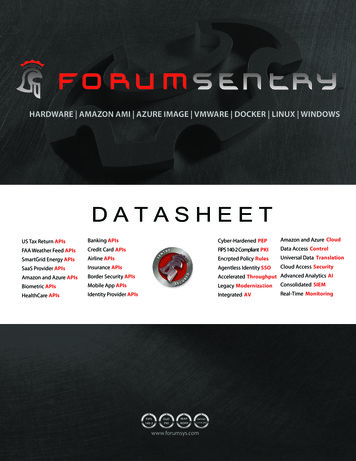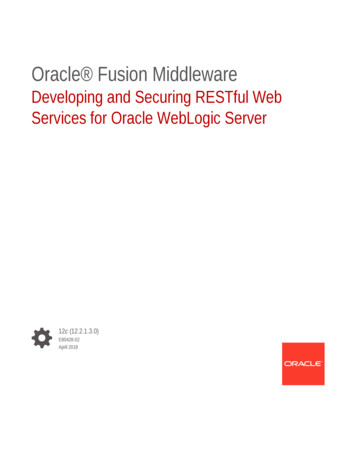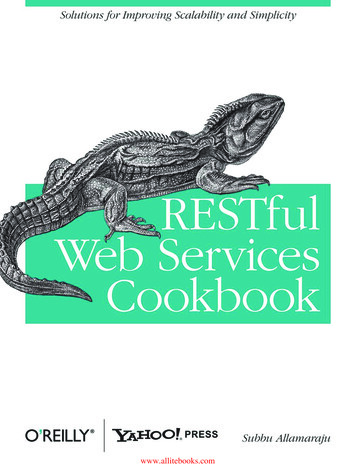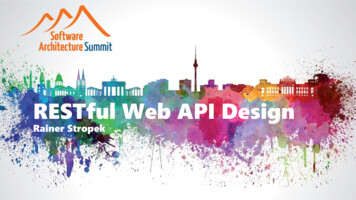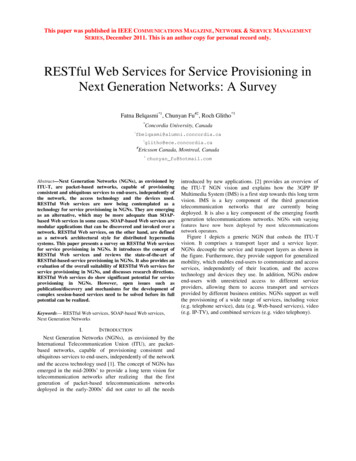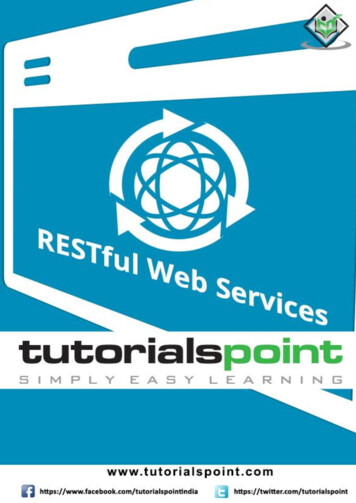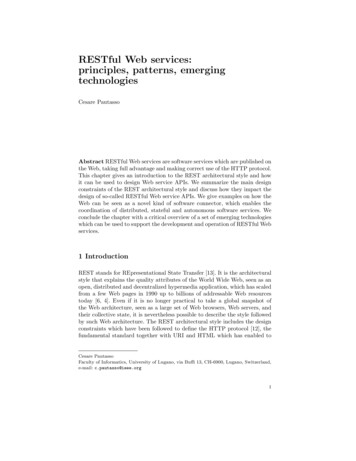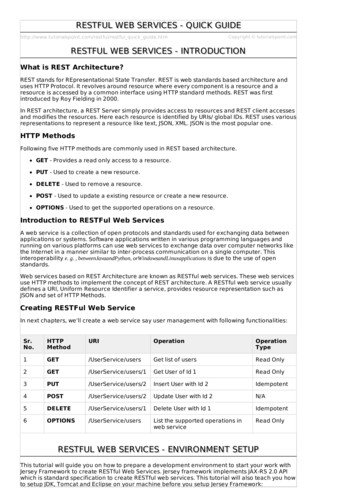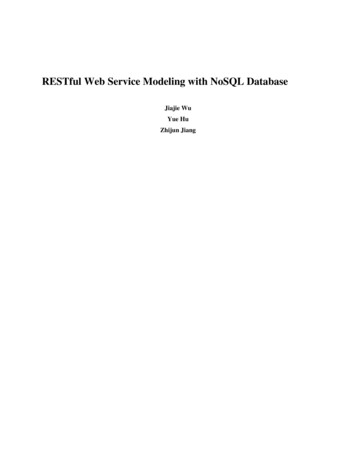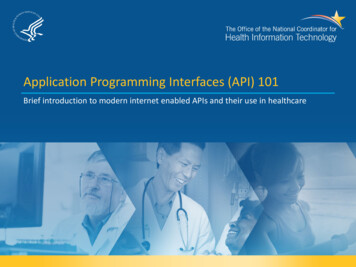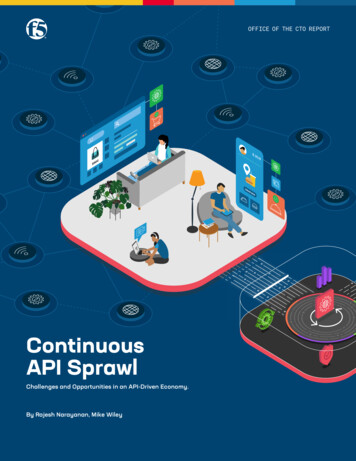
Transcription
www.allitebooks.com
www.allitebooks.com
Praise for RESTful Web APIs“This book is the best place to start learning the essential craft of API Design.”—Matt McLartyCofounder, API Academy“The entire time I read this book, I was cursing. I was cursing because as I read eachexplanation, I was worried that they were so good that it would be hard to find a better oneto use in my own writing. You will not find another work that explores the topic sothoroughly yet explains the topic so clearly. Please, take these tools, build somethingfantastic, and share it with the rest of the world, okay?”—Steve KlabnikAuthor, Designing Hypermedia APIs“Wonderfully thorough treatment of hypermedia formats,REST’s least well understood tenet."—Stefan TilkovREST evangelist, author, and consultant“The best practical guide to hypermedia APIs. A must-have.”— Ruben VerborghSemantic hypermedia researcherwww.allitebooks.com
www.allitebooks.com
RESTful Web APIsLeonard Richardson and Mike AmundsenForeword by Sam Rubywww.allitebooks.com
RESTful Web APIsby Leonard Richardson and Mike Amundsen with a Foreword by Sam RubyCopyright 2013 Leonard Richardson, amundsen.com, Inc., and Sam Ruby. All rights reserved.Printed in the United States of America.Published by O’Reilly Media, Inc., 1005 Gravenstein Highway North, Sebastopol, CA 95472.O’Reilly books may be purchased for educational, business, or sales promotional use. Online editions arealso available for most titles (http://my.safaribooksonline.com). For more information, contact our corporate/institutional sales department: 800-998-9938 or corporate@oreilly.com.Editors: Simon St. Laurent and Meghan BlanchetteProduction Editor: Christopher HearseCopyeditor: Jasmine KwitynProofreader: Linley DolbySeptember 2013:Indexer: Judith McConvilleCover Designer: Randy ComerInterior Designer: David FutatoIllustrator: Rebecca DemarestFirst EditionRevision History for the First Edition:2013-09-10:First releaseSee http://oreilly.com/catalog/errata.csp?isbn 9781449358068 for release details.Nutshell Handbook, the Nutshell Handbook logo, and the O’Reilly logo are registered trademarks of O’ReillyMedia, Inc. RESTful Web APIs, the image of Hoffmann’s two-toed sloth, and related trade dress are trade‐marks of O’Reilly Media, Inc.Many of the designations used by manufacturers and sellers to distinguish their products are claimed astrademarks. Where those designations appear in this book, and O’Reilly Media, Inc., was aware of a trade‐mark claim, the designations have been printed in caps or initial caps.While every precaution has been taken in the preparation of this book, the publisher and authors assumeno responsibility for errors or omissions, or for damages resulting from the use of the information containedherein.ISBN: 978-1-449-35806-8[LSI]www.allitebooks.com
For Sienna, Dalton, and Maggie. —LeonardFor Milo “The Supervisor,” my constant and patient companion throughout this and somany other projects. Thanks, buddy! —Mikewww.allitebooks.com
www.allitebooks.com
Table of ContentsForeword. . . . . . . . . . . . . . . . . . . . . . . . . . . . . . . . . . . . . . . . . . . . . . . . . . . . . . . . . . . . . . . . . . . . xiiiIntroduction. . . . . . . . . . . . . . . . . . . . . . . . . . . . . . . . . . . . . . . . . . . . . . . . . . . . . . . . . . . . . . . . . . xv1. Surfing the Web. . . . . . . . . . . . . . . . . . . . . . . . . . . . . . . . . . . . . . . . . . . . . . . . . . . . . . . . . . . . . 1Episode 1: The BillboardResources and RepresentationsAddressabilityEpisode 2: The Home PageShort SessionsSelf-Descriptive MessagesEpisode 3: The LinkStandardized MethodsEpisode 4: The Form and the RedirectApplication StateResource StateConnectednessThe Web Is Something SpecialWeb APIs Lag Behind the WebThe Semantic Challenge2233456891011131415162. A Simple API. . . . . . . . . . . . . . . . . . . . . . . . . . . . . . . . . . . . . . . . . . . . . . . . . . . . . . . . . . . . . . . 17HTTP GET: Your Safe BetHow to Read an HTTP ResponseJSONCollection JSONWriting to an APIHTTP POST: How Resources Are BornLiberated by Constraints18182021222425vwww.allitebooks.com
Application Semantics Create the Semantic Gap273. Resources and Representations. . . . . . . . . . . . . . . . . . . . . . . . . . . . . . . . . . . . . . . . . . . . . . . 29A Resource Can Be AnythingA Representation Describes Resource StateRepresentations Are Transferred Back and ForthResources with Many RepresentationsThe Protocol Semantics of HTTPGETDELETEIdempotencePOST-to-AppendPUTPATCHLINK and UNLINKHEADOPTIONSOverloaded POSTWhich Methods Should You Use?303031323334353637373839404041424. Hypermedia. . . . . . . . . . . . . . . . . . . . . . . . . . . . . . . . . . . . . . . . . . . . . . . . . . . . . . . . . . . . . . . 45HTML as a Hypermedia FormatURI TemplatesURI Versus URLThe Link HeaderWhat Hypermedia Is ForGuiding the RequestPromises About the ResponseWorkflow ControlBeware of Fake Hypermedia!The Semantic Challenge: How Are We Doing?464950515252535455565. Domain-Specific Designs. . . . . . . . . . . . . . . . . . . . . . . . . . . . . . . . . . . . . . . . . . . . . . . . . . . . 59Maze XML: A Domain-Specific DesignHow Maze XML WorksLink RelationsFollow a Link to Change Application StateThe Collection of MazesIs Maze XML an API?Client #1: The GameA Maze XML ServerClient #2: The Mapmakervi Table of Contentswww.allitebooks.com606162646567687274
Client #3: The BoasterClients Do the Job They Want to DoExtending a StandardThe Mapmaker’s FlawThe Fix (and the Flaw in the Fix)Maze as MetaphorMeeting the Semantic ChallengeWhere Are the Domain-Specific Designs?The Prize at the EndHypermedia in the HeadersSteal the Application SemanticsIf You Can’t Find a Domain-Specific Design, Don’t Make OneKinds of API ClientsHuman-Driven ClientsAutomated Clients7677778081838383848484868686876. The Collection Pattern. . . . . . . . . . . . . . . . . . . . . . . . . . . . . . . . . . . . . . . . . . . . . . . . . . . . . . . 91What’s a Collection?Collections Link to ItemsCollection JSONRepresenting the ItemsThe Write TemplateSearch TemplatesHow a (Generic) Collection WorksGETPOST-to-AppendPUT and PATCHDELETEPaginationSearch FormsThe Atom Publishing Protocol (AtomPub)AtomPub Plug-in StandardsWhy Doesn’t Everyone Use AtomPub?The Semantic Challenge: How Are We 67. Pure-Hypermedia Designs. . . . . . . . . . . . . . . . . . . . . . . . . . . . . . . . . . . . . . . . . . . . . . . . . . 109Why HTML?HTML’s CapabilitiesHypermedia ControlsPlug-in Application SemanticsMicroformatsThe hMaze Microformat109110110111113114Table of Contents vii
MicrodataChanging Resource StateAdding Application Semantics to FormsThe Alternative to Hypermedia Is MediaHTML’s LimitsHTML 5 to the Rescue?The Hypertext Application LanguageSirenThe Semantic Challenge: How Are We Doing?1161171191221241241251291308. Profiles. . . . . . . . . . . . . . . . . . . . . . . . . . . . . . . . . . . . . . . . . . . . . . . . . . . . . . . . . . . . . . . . . . 133How Does A Client Find the Documentation?What’s a Profile?Linking to a ProfileThe profile Link RelationThe profile Media Type ParameterSpecial-Purpose Hypermedia ControlsProfiles Describe Protocol SemanticsProfiles Describe Application SemanticsLink RelationsUnsafe Link RelationsSemantic DescriptorsXMDP: The First Machine-Readable Profile FormatALPSAdvantages of ALPSALPS Doesn’t Do EverythingJSON-LDEmbedded DocumentationIn 501501541559. The Design Procedure. . . . . . . . . . . . . . . . . . . . . . . . . . . . . . . . . . . . . . . . . . . . . . . . . . . . . . 157Two-Step Design ProcedureSeven-Step Design ProcedureStep 1: List the Semantic DescriptorsStep 2: Draw a State DiagramStep 3: Reconcile NamesStep 4: Choose a Media TypeStep 5: Write a ProfileStep 6: ImplementationStep 7: PublicationExample: You Type It, We Post ItList the Semantic Descriptorsviii Table of Contents157158159161164167169169170173173
Draw a State DiagramReconcile NamesChoose a Media TypeWrite a ProfileSome Design AdviceResources Are Implementation DetailsDon’t Fall into the Collection TrapDon’t Start with the Representation FormatURL Design Doesn’t MatterStandard Names Are Probably Better Than Your NamesIf You Design a Media TypeWhen Your API ChangesDon’t Keep All the Hypermedia in One PlaceAdding Hypermedia to an Existing APIFixing Up an XML-Based APIIs It Worth It?Alice’s Second AdventureEpisode 1: The Nonsense RepresentationEpisode 2: The ProfileAlice Figured It 219219219419610. The Hypermedia Zoo. . . . . . . . . . . . . . . . . . . . . . . . . . . . . . . . . . . . . . . . . . . . . . . . . . . . . . . 199Domain-Specific FormatsMaze XMLOpenSearchProblem Detail DocumentsSVGVoiceXMLCollection Pattern FormatsCollection JSONThe Atom Publishing ProtocolODataPure Hypermedia FormatsHTMLHALSirenThe Link HeaderThe Location and Content-Location HeadersURL ListsJSON Home DocumentsThe Link-Template 17218218219219220221Table of Contents ix
XLinkXFormsGeoJSON: A Troubled TypeGeoJSON Has No Generic Hypermedia ControlsGeoJSON Has No Media TypeLearning from GeoJSONThe Semantic ZooThe IANA Registry of Link RelationsThe Microformats WikiLink Relations from the Microformats Wikischema.orgDublin CoreActivity StreamsThe ALPS 11. HTTP for APIs. . . . . . . . . . . . . . . . . . . . . . . . . . . . . . . . . . . . . . . . . . . . . . . . . . . . . . . . . . . . . 237The New HTTP/1.1 SpecificationResponse CodesHeadersChoosing Between RepresentationsContent NegotiationHypermedia MenusThe Canonical URLHTTP PerformanceCachingConditional GETLook-Before-You-Leap RequestsCompressionPartial GETPipeliningAvoiding the Lost Update ProblemAuthenticationThe WWW-Authenticate and Authorization HeadersBasic AuthOAuth 1.0Where OAuth 1.0 Falls ShortOAuth 2.0When to Give Up on OAuthExtensions to HTTPThe PATCH MethodThe LINK and UNLINK MethodsWebDAVx Table of 248249250251252255256256257257258259
HTTP 2.026012. Resource Description and Linked Data. . . . . . . . . . . . . . . . . . . . . . . . . . . . . . . . . . . . . . . . 263RDFRDF Treats URLs as URIsWhen to Use the Description StrategyResource TypesRDF SchemaThe Linked Data MovementJSON-LDJSON-LD as a Representation FormatHydraThe XRD FamilyXRD and JRDWeb Host Metadata DocumentsWebFingerThe Ontology Zooschema.org RDFFOAFvocab.orgConclusion: The Description Strategy 428528528613. CoAP: REST for Embedded Systems. . . . . . . . . . . . . . . . . . . . . . . . . . . . . . . . . . . . . . . . . . . 287A CoAP RequestA CoAP ResponseKinds of MessagesDelayed ResponseMulticast MessagesThe CoRE Link FormatConclusion: REST Without HTTP288288289290291291293A. The Status Codex. . . . . . . . . . . . . . . . . . . . . . . . . . . . . . . . . . . . . . . . . . . . . . . . . . . . . . . . . . 295B. The Header Codex. . . . . . . . . . . . . . . . . . . . . . . . . . . . . . . . . . . . . . . . . . . . . . . . . . . . . . . . . 317C. An API Designer’s Guide to the Fielding Dissertation. . . . . . . . . . . . . . . . . . . . . . . . . . . . 341Glossary. . . . . . . . . . . . . . . . . . . . . . . . . . . . . . . . . . . . . . . . . . . . . . . . . . . . . . . . . . . . . . . . . . . . . 357Index. . . . . . . . . . . . . . . . . . . . . . . . . . . . . . . . . . . . . . . . . . . . . . . . . . . . . . . . . . . . . . . . . . . . . . . 361Table of Contents xi
ForewordProgressive Disclosure is a concept in User Interface Design which advocates only pre‐senting to the user the information they need when they need it. In many ways, the bookyou are reading right now is an example of this principle. In fact, it is quite likely thatthis book wouldn’t have “worked” a mere seven years ago.For you see, the programming world was quite a different place when RESTful WebServices, the predecessor of this book, was written. At that time, the term “REST” waswas rarely used. And when it was used it was often misapplied, and widely misunder‐stood.This was the case despite the fact that the standards upon which REST is based, namelyHTTP and HTML, were developed and became IETF and W3C standards in roughlytheir current form in the second half of the 1990s. Roy Fielding’s thesis paper in whichhe introduced the term REST and on which this book was based was itself published in2000.Leonard Richardson and I set out to correct this injustice. To do this, we focused pri‐marily on the concepts underpinning HTTP, and we provided practical guidance onhow to apply those concepts to applications.I’d like to think that we helped kick a few pebbles loose that started the avalanche ofsupport for REST that came forth since that time. REST rapidly took on a life of its own,and in the process has become a buzzword. In fact it now is pretty much the case thatpresenting a web interface and calling it REST is practically the default. We’ve definitelycome a long way in a few short years.Admittedly, REST as a term is often over applied, and not always correctly. But all thingsconsidered, I am very pleased that the concepts of resources and URIs have successfullymanaged to infiltrate their way into application interface design. The web, after all, is aresilient place, and these new interfaces, albeit imperfect, are leaps and bounds betterthan the ones that they replace.But we can do better.xiii
Now that those building blocks are in place, it is time to take a step back, survey theterritory, and build on top of these concepts. The next logical step is to explore mediatypes in general, and hypermedia formats in specific. While the first book focused almostexclusively on the correct application of HTTP, it is time to delve more deeply into theconcepts behind hypertext media types like HTML—media types that aren’t tightlybound to a single application or even a single vendor.HTML remains a prime example of a such a hypermedia format, and it continues tohold a special place in web architecture. In fact, my personal journey of discovery hasbeen to take a deep dive into development of the W3C standard for HTML, now brandedas HTML5. And while HTML does have a prominent place in this new book, there isso much more to cover on the topic of hypermedia. So while I have remained in touch,Leonard picked up a capable replacement for my role as coauthor in Mike Amundsen.It has been a pleasure to watch this book be written, and in reading this book I’ve learnedabout a number of media types that I had not been exposed to by any other source. Moreimportantly, this book shows what these types have in common, and how to differentiatethem, as each has its own specialty.Hopefully the pebbles that this book kicks loose will have the same effect as its prede‐cessor did. Who knows, perhaps in another seven years it will be time to do this all overagain, and highlight some other facet of Representational State Transfer that continuesto be under-appreciated.—Sam Rubyxiv Foreword
Introduction“Most software systems are created with the implicit assumption that the entire systemis under the control of one entity, or at least that all entities participating within a systemare acting towards a common goal and not at cross-purposes. Such an assumption cannotbe safely made when the system runs openly on the Internet.”— Roy FieldingArchitectural Styles and the Design ofNetwork-based Software Architectures“A Discordian Shall Always use the Official Discordian Document Numbering System.”— Malaclypse the Younger and LordOmar Khayyam RavenhurstPrincipia DiscordiaI’m going to show you a better way to do distributed computing, using the ideas un‐derlying the most successful distributed system in history: the World Wide Web. I hopeyou’ll read this book if you’ve decided (or your manager has decided) that your companyneeds to publish a web API. It doesn’t matter whether you’re planning a public API, apurely internal API, or an API accessible by trusted partners—they can all benefit fromthe philosophy of REST.This is not necessarily the book for you if you want to learn how to write API clients.That’s because most existing API designs are based on assumptions that are several yearsold, assumptions that I’d like to destroy.Most of today’s APIs have a big problem: once deployed, they can’t change. There arebig-name APIs that stay static for years at a time, as the industry changes around them,because changing them would be too difficult.But RESTful architectures are designed for managing change. The World Wide Web ismade of millions of websites, running atop thousands of different server implementa‐tions, and undergoing periodic redesigns. Websites are accessed by billions of users whoare using hundreds of different client implementations on dozens of hardware plat‐xv
forms. Your deployment won’t look like this howling mess, but the closer you come toweb scale, the more familiar this picture will look.A very simple system is always easy to change. At small scales, a RESTful system has alarger up-front design cost than a push-button solution. But as your API matures andstarts to change, you’ll really need some way—like REST—of adapting to change. An API that’s commercially successful will stay available for years on end. SomeAPIs have hundreds or even thousands of users. Even if the problem domain onlychanges occasionally, the cumulative effect on clients can be huge. Some APIs change all the time, with new data elements and business rules con‐stantly being added. In some APIs, each client can change the workflow to suit its needs. Even if the APIitself never changes, each client will experience it differently. The people who write the API clients usually don’t work on the same team as thepeople who write the servers. All APIs that are open to the public fall under thiscategory. If you don’t know what kind of clients are out there, you need to be verycareful about making changes—or you need to have a design that can changewithout breaking all the clients.If you copy existing designs for your API, you will probably only repeat the mistakes ofthe past. Unfortunately, most of the improvements are happening below the surface, inexperiments and through slow-moving standards processes. I’ll cover dozens of specifictechnologies in this book, including many that are still under development. But my maingoal is to teach you the underlying principles of REST. Learn those, and you’ll be ableto exploit whichever experiments pan out and whichever standards are approved.There are two specific problems I’m trying to solve with this book: duplication of effortand avoidance of hypermedia. Let’s take a look at them.Duplication of EffortAn API released today will be named after the company that hosts it. We talk about the“Twitter API,” the “Facebook API,” and the “Google API.” These three APIs do similarthings. They all have some notion of user accounts and (among other things) they alllet users post a little bit of text to their accounts. But each API has a completely differentdesign. Learning one API doesn’t help you learn the next one.Of course, Twitter, Facebook, and Google are big companies that compete with eachother. They don’t want to make it easy for you to learn their competitors’ APIs. But smallcompanies and nonprofits do the same thing. They design their APIs as though nobodyelse had ever had a similar idea. This interferes with their goal of getting people toactually use their APIs.xvi Introductionwww.allitebooks.com
Let me show you just one example. The website ProgrammableWeb has a directory ofover 8,000 APIs. As I write this, it knows about 57 microblogging APIs—APIs whosemain purpose is posting a little bit of text to a user account.1 It’s great that there are 57companies publishing APIs in this field, but do we really need 57 different designs? We’renot talking about something complicated here, like insurance policies or regulatorycompliance. We’re talking about posting a little bit of text to a user account. Do youwant to be the one who designs the 58th microblogging API?The obvious solution would be to create a standard for microblogging APIs. But therealready is a standard that would work just fine: the Atom Publishing Protocol. It waspublished in 2005, and almost nobody uses it. There’s something about APIs that makeseveryone want to design their own from scratch, even when that makes no sense froma business perspective.I don’t think I can single-handledly stop this wasted effort, but I do think I can breakdown the problem into parts that make sense, and present some ways for a new API toreuse work that’s already been done.Hypermedia Is HardBack in 2007, Leonard Richardson and Sam Ruby wrote the predecessor to this book,RESTful Web Services (O’Reilly). That book also tried to address two big problems. Oneof the problems has been solved; the other is nowhere close to being solved.2The first problem: in 2007, the REST school of API design was engaged in a standoffagainst a rival school that used heavyweight technologies based on SOAP and ques‐tioned the very legitimacy of the REST school. RESTful Web Services was a salvo in thisstandoff, a defense of RESTful design principles against the attacks of the SOAP school.Well, the standoff is over, and REST won. SOAP APIs are still used, but only within thebig companies that were backing the SOAP school in the first place. Pretty much all newpublic-facing APIs pay lip service to RESTful principles.3Which brings me to the second problem: REST isn’t just a technical term—it’s also amarketing buzzword. For a long time, REST was a slogan that signified nothing beyondopposition to the SOAP school. Any API that didn’t use SOAP was marketed as REST,1. The full list of ProgrammableWeb APIs tagged with microblogging provides information about each of theseAPIs.2. RESTful Web Services is now freely available as part of O’Reilly’s Open Books Project. You can download aPDF copy of the book from the book’s page.3. If you’re wondering, this is why we changed the title. The term “web services” became so tightly coupled withSOAP that when SOAP went down, it took “web services” with it. These days, everyone talks about APIsinstead.Introduction xvii
even if its design made no sense or betrayed the technical principles of REST. This wasinaccurate, confusing, and it gave REST—i.e., REST as a technical term—a bad name.This situation has improved a lot since 2007. When I look at new APIs, I see the workof developers who understand the concepts I’ll be explaining in the first few chaptersof this book. Most developers who fly the REST flag today understand resources andrepresentations, how to name resources with URLs, and how to properly use HTTPmethods. The first three chapters of this book don’t do much but get new developers upto speed.But there’s one aspect of REST that most developers still don’t understand: hypermedia.We all understand hypermedia in the context of the Web. It’s just a fancy word for links.Web pages link to each other, and the result is the World Wide Web, driven by hyper‐media. But it seems we’ve got a mental block when it comes to hypermedia in web APIs.This is a big problem, because hypermedia is the feature that makes a web API capableof handling changes gracefully.Starting in Chapter 4, my overriding goal for RESTful Web APIs will be to teach youhow hypermedia works. If you’ve never heard of this term, I’ll teach it to you along withthe other important REST concepts. If you’ve heard of hypermedia but the conceptintimidates you, I’ll do what I can to build up your courage. If you just haven’t been ableto wrap your head around hypermedia, I’ll show it to you in every way I can think of,until you get it.RESTful Web Services covered hypermedia, but it wasn’t central to the book. It waspossible to skip the hypermedia parts of the book and still design a functioning API. Bycontrast, RESTful Web APIs is effectively a book about hypermedia.I did it this way because hypermedia is the single most important aspect of REST, andthe least understood. Until we all understand hypermedia, REST will continue to beviewed as a marketing buzzword rather than a serious attempt to handle the complexityof distributed computing.What’s in This Book?The first four chapters introduce the concepts behind REST, as it applies to web APIs.Chapter 1, Surfing the WebThis chapter explains basic terminology using a RESTful system you’re already fa‐miliar with: a website.Chapter 2, A Simple APIThis chapter translates the lessons of the Web to a programmable API with identicalfunctionality to the website discussed in Chapter 1.xviii Introduction
Chapter 3, Resources and RepresentationsResources are the fundamental concept underlying HTTP, and representations arethe fundamental concept underlying REST. This chapter explains how they’re re‐lated.Chapter 4, HypermediaHypermedia is the missing ingredient that ties representations together into a co‐herent API. This chapter shows what hypermedia is capable of, mostly using ahypermedia data format you’re already familiar with: HTML.The next four chapters describe different strategies for designing a hypermedia API:Chapter 5, Domain-Specific DesignsThe obvious strategy is to design a completely new standard that deals with yourexact problem. I use the Maze XML standard as an example.Chapter 6, The Collection PatternOne pattern in particular—the collection pattern—shows up over and over againin API design. In this chapter, I show off two different standards that capture thispattern: Collection JSON and AtomPub.Chapter 7, Pure-Hypermedia DesignsWhen the collection pattern doesn’t fit your requirements, you can convey anyrepresentation you want using a general-purpose hypermedia format. This chaptershows how it works using three general hypermedia formats (HTML, HAL, andSiren) as examples. This chapter also introduces HTML microformats and micro‐data, which lead in to the next chapter.Chapter 8, ProfilesA profile fills in the gaps between a data format (which can be used by many differentAPIs) and a specific API implementation. The profile format I recommend is ALPS,but I also cover XMDP and JSON-LD.In this chapter, my advice begins to outstrip the state of the art at the time this bookwas written. I had to develop the ALPS format for this book, because nothing elsewould do the job. If you’re already familiar with hypermedia-based designs, youmight be able to skip up to Chapter 8, but I don’t think you should skip past it.Chapters 9 through 13 cover practical topics like choosing the right hypermedia formatand getting the most out of the HTTP protocol.Chapter 9, The Design ProcedureThis chapter brings together everything discussed in the book so far, and gives astep-by-step guide to designing a RESTful API.Introduction xix
Chapter 10, The Hypermedia ZooIn an attempt to show what hypermedia is capable of, this chapter discusses about20 standardized hypermedia data formats, most of them not covered elsewhere inthe book.Chapter 11, HTTP for APIsThis chapter gives some best practices for the use of HTTP in API implementations.I also discuss some extensions to HTTP, including the forthcoming HTTP 2.0 pro‐tocol.Chapter 12, Resource Description and Linked DataLinked Data is the Semantic Web community’s approach to REST. JSON-LD isarguably the most important Linked Data standard. It’s covered briefly in Chap‐ter 8, and I revisit it here. This chapter also covers the RDF data model, and someRDF-based hypermedia formats that I didn’t get to in Chapter 10.Chapter 13, CoAP: REST for Embedded SystemsThis chapter closes out the core body of the book by covering CoAP, a RESTfulprotocol that doesn’t use HTTP at all.Appendix A, The Status CodexAn extension of Chapter 11, this appendix provides an in-depth look at the 41standard status codes defined in the HTTP specification, as well as a few usefulcodes defined as extensions.Appendix B, The Header CodexSimilar to Appendix A, this appendix is also an extension of Chapter 11. It providesa detailed outline of the 46 request and response headers defined in the HTTPspecification, as well as a few extensions.Appendix C, An API Designer’s Guide to the Fielding DissertationThis appendix includes an in-depth discussion of the foundational document ofREST, in terms of what it means for API design.GlossaryThe glossary contains definitions to terms you’ll frequently encounter when work‐ing with RESTful web APIs. It’s a good place to turn for familiarizing yourself withbasic concepts or if you need a quick, at-a-glance reminder of a particular concept’sdefinition.What’s Not in This BookRESTful Web Services was the first book-length treatment of REST, and it had to covera lot of ground. Fortunately, there are now over a dozen books on various aspects ofREST, and that frees up RESTful Web APIs to focus on the core concepts.xx Introduction
To keep this book focused, I’ve removed a few topics that you might have been expectingme to cover. I want to tell you what is not in this book, so that you don’t buy it and thenfeel disappointed: Client programming is not covered here. Writing a client to consume a hypermediabased API is a new kind of challenge. Right now, the closest thing we have to ageneric API client is a library that sends HTTP requests. This was true in 2007, andit’s still true. The problem is on the server side.When you write a client for an existing API, you’re at the mercy of the API designer.I can’t give you any general advice, because right now there’s no consistency acrossAPIs. That’s why, in this book, I’m trying to drum up enthusiasm for a little serverside consistency. When APIs become more similar to each other, we’ll be abl
Praise for RESTful Web APIs "This book is the best place to start learning the essential craft of API Design." —Matt McLarty Cofounder, API Academy "The entire time I read this book, I was cursing. I was cursing because as I read each explanation, I was worried that they were so good that it would be hard to find a better one
